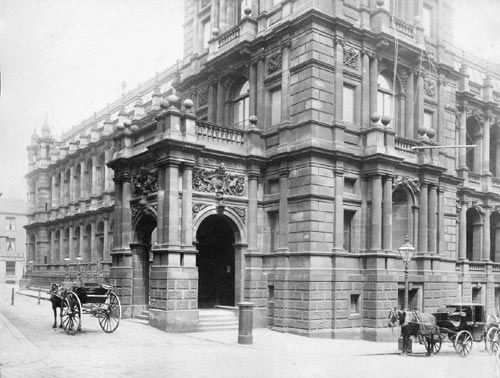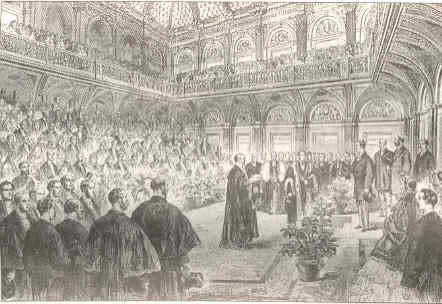
IT MUST have been one of the grandest, most spectacular events (and maybe the wettest) in the history of Halifax - the visit by the Prince of Wales in 1863 to open the new Halifax Town Hall.

In politics
Col. William Irving Holdsworth was a Conservative, and at the close of 1860 he entered Halifax Town Council, being present at the ceremony of the laying of the cornerstone of the Halifax Town Hall - having been delayed by a stone masons' strike. The building opened on Tuesday, 4th August 1863 by HRH The Prince of Wales - later King Edward VII; the Princess of Wales was ill and could not attend.
358 trains brought around 70,000 people to the town on the opening day, and 870 police were in attendance. There was a special Piece Hall Sing for the Prince of Wales.
William Holdsworth became Alderman, was made a Justice of the Peace for the Borough, and was later elected Mayor of Halifax in 1863-4; and 1864-5, devoting much of his time to the welfare of the townspeople of Halifax.
The town itself was decked out like a carnival for the visit of the future King Edward VII, who also visited several of the town's most important mill complexes and dined at Manor Heath, home of the Mayor of Halifax, John Crossley, as well as leading a grand procession through the town to the town hall.
There were amazing scenes in the decorated streets and in the Piece Hall, where thousands of Sunday school scholars sang hymns from specially constructed stands.
An estimated 100,000 people visited Halifax to join the celebrations, which were on a huge scale. To illustrate the sheer size of the event one just has to look at the transport and policing arrangements.
The Lancashire and Yorkshire Railway put on staggering 358 trains to Halifax on the two days of the Prince's visit, August 3 and 4, 1863. As many as 70,000 tickets were issued from stations to Halifax on the first day alone.
Two hundred and fifty men were on duty at Halifax station, yet the trains could not be emptied fast enough to cope with those queuing behind. A man was stationed at every mile along the tracks from Halifax to Bradford, Cleckheaton, Wakefield and Todmorden with special signals to cope with the streams of trains.
In the town the crowds were watched by 870 police, 200 of them from London and others from Liverpool, Leeds, Sheffield and elsewhere.
The only clouds hanging over these remarkable two days appears to have been the incessant rain from late on the Monday, which reduced the number of visitors and left some of the specially erected spectator stands less than full, and disappointment that the Princess of Wales, who was due to accompany her husband, was indisposed and unable to make the journey.

The "Halifax Courier", then a weekly paper, filled its columns with the event, which it described as being "for ever memorable in the history of this town".
The "Courier" commented: "Even though shorn of its principle attraction through the unfortunate absence of the Princess of Wales, and though dimmed as regards its pomp and circumstance owing to the rain which fell at so very inconvenient a time, the opening of the new town hall by the Prince of Wales is still an event of which Halifax may well be proud."
Of the remarkable street decorations the "Courier" wrote: "The enthusiasm and almost unbounded devotion of a people to their future monarch has been symbolised in every form of decorative skill and beauty, by gay banners, many coloured flags and the ornamentations of the designers, vying with nature, ever profuse in her lovely gifts, to form floral designs of the of the most varied, chaste and unique description. Our very streets were redolent with the fragrance of the flower garden."
However, the rain was a nuisance: "The rain began to fall somewhat heavily by eleven o'clock on Monday night and, as far as we can learn, continued to fall all night. From a very early hour in the morning it descended literally in torrents, ceaselessly, pitilessly. It would be impossible to calculate the amount of real misery experienced here."
Still, stoical Tykes were not going to let a spot of rain spoil the party.
The Prince had arrived at Halifax station at 3pm on Monday the 3rd, the moment heralded by the firing of a royal salute by two 32 pounders of the Heckmondwike Volunteer Artillery Corps on Beacon Hill. The Prince was met by the Mayor and councillors and a guard of honour was mounted by 300 of the Halifax Volunteer Riflemen.
Lunch was taken at the Mayor's home, Manor Heath, before the royal party visited the carpet works of John Crossley and Sons at Dean Clough, James Akroyd and Sons' mills at Haley Hill and John Whiteley and Sons' Brunswick Mills in West Parade.
A banquet followed at Manor Heath, attended by many of the great and good, serenaded in the rain by a hundred singers in the illuminated gardens. There was a balloon ascent from West Hill Park, the Crossleys' industrial village off Gibbet Street, and a fireworks display in fields at Ward's End.

On the following day an imposing carriage procession left Manor Heath at 11.20 am, travelling via Albert Promenade to King Cross and then on to the new People's Park -a gift by another of the Crossleys, Sir Francis, in 1857- which the prince inspected on foot.
The procession continued via Bull Green and Horton Street to the Piece Hall, where the Prince was greeted by the deafening cheers of 10,000 Sunday school teachers and scholars, with 300 instrumentalists and 200 singers.
Then via Westgate, Northgate and North Bridge to All Souls' Church, which the Prince inspected and on via North Parade, St James's Road, Cow Green, Silver Street and Princess Street to the Town Hall, designed by Sir Charles Barry, designer of the Houses of Parliament, and completed by his son, Edward Middleton Barry.
The Prince was conducted by the Mayor into the Victoria Hall where, before a "brilliant assembly" the town clerk read the loyal address. The Prince replied stating: "I am proud to take (part) in the ceremony of inaugurating your Town Hall, in which I see so much to admire, whether in regard to its design, the execution or the mode in which its cost is met.
"Indeed the general prosperity of your town and the industry, which is aided by the most ingenious machinery, has so long distinguished its inhabitants can not fail to strike every visitor with wonder and admiration.
Lunch followed and the royal party left the Town Hall at 3pm and the station at 3.15.

On August 11 1863 the Town Hall was opened to the public for the first time and the first council meeting was held there on September 18.
Marble busts of the Queen, her husband Prince Albert, their son Albert Edward and his wife Alexandra were presented by the Mayor of Halifax, Alderman John Crossley and Alderman William Holdsworth.
These large-as-life marble busts were stored in the basement for over 50 years when it was redecorated in 1954.
On 6 September 2008 the caringly restored busts were returned to their rightful place, and unveiled by The Lord Lieutenant of West Yorkshire,
Dr. Ingrid Roscoe,
Ben Crossley,
Ingrid Holdsworth and the Mayor of Calderdale, Cllr. Conrad Winterburn.
The history-making visit by the Prince of Wales -the first to Halifax by a member of the British Royal Family -is touched on by local historian John L Hargreaves in a paper entitled "Long to reign over us", about changing attitudes towards the monarchy in Halifax from the golden jubilee of George III in 1809 ~ to the golden jubilee of our present Queen in 2002.
Dr Hargreaves's article is one of almost a dozen papers on aspects of local history ranging through the centuries and throughout Calderdale in the latest volume of the Transactions of the A Halifax Antiquarian Society.
They include pieces on prehistoric activity in the central South Pennines; "The Patchetts of Midgley: the origins of a family of 18th and 19th-century publicans"; the story of the 17th-century Halifax physician, Dr Henry Power; the English Presbyterian and later Unitarian congregation in Elland; the diary of Henry William Pohlmann, of the Halifax if family of piano makers; and the story of Mons Mill, Todmorden.
The transactions, which cost £12, are in local bookshops or can be ordered from the antiquarian society's publications officer,
Derek Bridge,
3, First Avenue,
Manor Drive,
Halifax
(Tel: 363493).
January 2004
|
©
2026
David W. Holdsworth |
|
Please send questions, updates, additions to: |